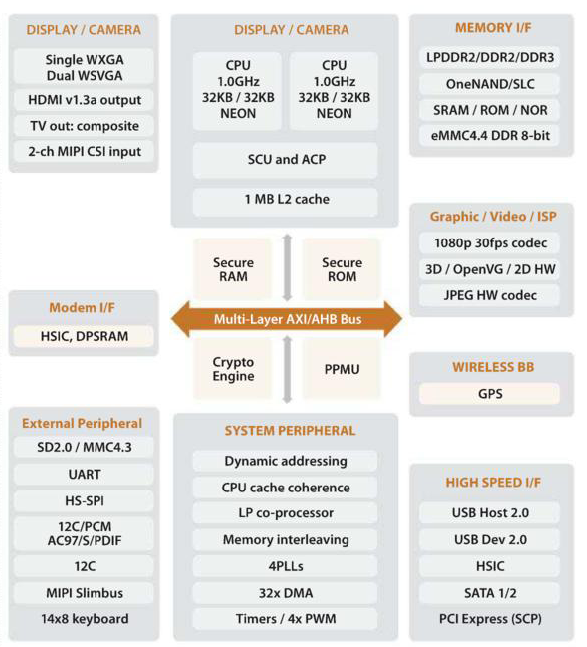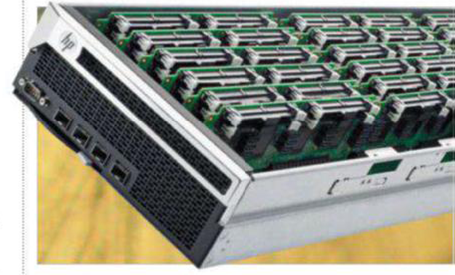Processor and cores

The
ARM Cortex-based Exynos 4210 from Samsung provides most of the functionality of
a smartphone in a single chip
To most technically-minded PC users, a
processor is the large component that sits on the motherboard, and which forms
the heart of the PC. A core, on the other hand, of which there might be two,
four, six or eight, is a part of a processor that’s responsible for executing
instructions. Within ARM, though, the two terms have a somewhat different
meaning.
A processor is pretty much what most
people would expect - a design containing all the usual elements, including one
or more cores, cache memories and the bus interface. As such, it’s a design
that a semiconductor manufacturer can turn directly into a standard silicon
component. So, for example, several companies including Toshiba, NEC and TI
have ARM Cortex-A9 processors.
A core, on the other hand, is the
heart of a microprocessor that semiconductor manufacturers can build into their
own custom chip designs. That customised chip will often be much more than what
most people would think of as a processor, and could provide a significant
proportion of the functionality required in a particular device. Referred to as
a system on silicon (SoC) design, this type of chip minimises the number of
components, which, in turn, keeps down both the cost and the size of the
circuit hoard, both of which are essential for high volume portable products
such as smartphones.
A perfect example of the increasing
amount of functionality that’s being shoehorned into a single chip is the
Samsung Exynos 4210 SoC. Intended for smartphones, tablet PCs and netbooks, the
chip features a 1.2GHz dual-core ARM Cortex-A9, plus just about everything that
would be found as separate chips on the motherboard on a conventional PC. For
example, there’s on-chip 3D graphics and audio hardware, lO8Op video encode and
decode, plus interfaces for the display camera and keypad. There are also
memory, USB, PCI Express (expansion card), SATA (hard disk) and memory card
interfaces and, while the necessary RF (radio frequency circuitry would have to
be provided by a separate chip, there’s support for the various communication
channels including Wi-Fi, HSPA+ and LTE (3G and 4G mobile phone) and GPS.
Applications

According
to ARM,. the Mali-T658 GPU will bring desktop class graphics to mobile devices
We’ve seen that ARM processors and
cores are used in handheld anti portable devices like smartphones, tablet PCs
and netbooks, but this is only the tip of the iceberg. As Ed Plowan put it,
“You can walk around any branch of stores like Comet or Curry and he falling over
ARM devices, but you won’t know it”. Included here are the likes of games
consoles, personal media players, set-top boxes, Internet radios, home
automation systems, GPS receivers, chook readers, TVs, DVD and Blu-ray players,
digital cameras and home media servers. Cheaper, less powerful chips arc found
in less likely sounding home products, including toys, cordless phones and even
coffee makers. There’s a good chance that your car could contain a fair few
ARM-based devices too. They’re used to drive dashboard display, anti-lock
breaking, airbags and other safety-related systems, and for engine management.
Ed also mentioned healthcare products as a major growth area over the last five
years, with products varying from remote patient monitoring systems to medical
imaging scanners.
While your desktop or laptop PC wont
feature an ARM chip as its main processor, there’s a good chance that there’ll
be one or more hidden away somewhere doing some unexpected but important job.
ARM devices are used extensively in hard disk and solid state drives. They also
crop up in wireless keyboards, and are used as the driving force behind
printers and networking devices like wireless router/access points.
Before you jump to the conclusion that
ARM products are destined to play a supporting role in traditional computing
platforms indefinitel3 we really ought to mention the EU Mont-Blanc Project.
With the aim of providing high performance computing but without the high
energy consumption of today’s top supercomputers, project partner the Barcelona
Computing Centre is building a supercomputer from ARM-based Nvidia Tegra
processors. As yet there’s no indication of how many thousand of these chips
will be used and what level of performance will be achieved, but this first
ARM-based supercomputer will certainly break new ground in terms of energy
efficiency While the initial goal is to provide two to five times the
efficiency of x64-based supercomputers, this is expected to increase to as much
as 10 times by 2014 and the ultimate project aim is a 10-30 fold improvement.
The future of ARM

A
HP’s ARM-based Redstone server modules will increase data centre power
efficiency, with processors produced by Calxeda
The ARM architecture started out in a
desktop PC, and a powerful one at that. Now, after years of being hidden away
in a whole manner of consumer and industrial products, it has returned to the
world of computing by powering the latest generation of portable platforms. So
will ARM products once again power mainstream computers? I put that question to
Ed Plowman, who questioned our use of the term “mainstream” and turned the
question on its head by referring to the evolution of computing devices. “First
there was the desktop, and then the laptop, but the laptop was hindered by the
hick of connectivity”, he said. “All of this functionality plus connectivity
can now be provided in a device that’s always with us, but there’s a limit to
what you can do with a smartphone, which is why the tablet was developed. It
would be wrong to think of a tablet as just a bigger phone, though; it provides
a different way of presenting data and a different user experience. So ARM
isn’t moving into the mainstream but the mainstream is evolving to play into
ARM’s strengths such as low power consumption.
However we might define the
mainstream, there seems to be little doubt that ARM devices are being called on
to perform ever more processor-intensive tasks. The fact that this has been
achieved with a 32-bit architecture when most of the competition at the top end
has migrated to 64 bits is a testimony to the ARM architecture, but surely’
there’s a limit to how far 32-bit technology can be stretched. At ARM’s TechCon
conference in Santa Barbara in October last year, Ed mentioned the company’s
forthcoming ARMv8 architecture, which will be 64-bit throughout. He wasn’t
prepared to say when 64-bit designs will become available, but Ed was
enthusiastic about what it will offer. Availability of a 64-bit ARM core takes
us into interesting areas. People think it’s predominantly about taking us into
an Intel-type world, but there are lots of other advantages, not least of which
is the scope for vastly increasing use of memory.”
Indeed, coping with huge volumes of
data brings us to another new application for ARM devices as evidenced by the
recent announcement by HP of the Redstone server. This new product line uses
ARM Cortex-based processors produced by start-up company Calxeda. However, Ed
Plowman took issue with the suggestion that ARM’S entry into the large scale
server market was a radical change of direction.
“People think that servers are all
about high performance, but most applications arc data centres where the main
requirement is energy efficiency”, he said. “Electrical power is needed both to
run the hardware and for cooling, and this cost overrides the equipment cost.
With the continual requirement for larger and larger data centres, the number
of MIPS per unit area and power efficiency are becoming increasingly
important”. It’s interesting to note, therefore, that an aim of HP’s Project
Moonshot, of which the ARM-based Redstone server is a first element, is to
consume 89 per cent less energy and 94 per cent less space, while reducing overall
costs up to 63 per cent compared to traditional server systems.
ARM might be best known for its
microprocessors and cores, but GPUs are becoming an increasingly important part
of their portfolio with their newly announced MaIi-T658 representing the state
of the art. Needless to say this new product follows in the ARM niche of low
power consumption for handheld and portable devices, without sacrificing
performance. Indeed, a recent press release refers to desktop-class graphics on
mobile devices, and Ed went on to make the tantalising suggestion that it would
allow mobile phones to be driven via a gesture interface.
Whether we’ll ever see a desktop PC
proudly displaying an “ARM Inside” badge remains to be seen, and unless it does
the company will probably never become a household name. Yet ARM Holdings
appears in the FTSE 100 list of the UK’s most influential companies, employs
1,700 people, turns over more than $640 million, and demonstrates that a
British company can compete with the best that Silicon Valley has to offer.
With pundits continually talking down the British economy, perhaps you’ll
forgive us relishing in this success story for the British computer industry.